Getting Started with Web Development: Essential Tools and Best Practices.
 Sabat Ali
Sabat Ali
Web development is an exciting field that combines creativity and technical skills to build functional and visually appealing websites. Whether you are a complete beginner or looking to refresh your knowledge, this guide will cover the essential tools and best practices for HTML, CSS, and JavaScript, as well as some useful frameworks and principles that will enhance your development journey.
1. Understanding HTML, CSS, and JavaScript
HTML (HyperText Markup Language)
HTML is the foundation of web pages. It structures content on the web and is composed of elements represented by tags. Here are some basic concepts:
Tags and Elements: Tags like
<h1>,<p>, and<div>define headings, paragraphs, and divisions, respectively.Attributes: Tags can have attributes that provide additional information. For example,
<img src="image.jpg" alt="description">includes a source and an alternative text.
CSS (Cascading Style Sheets)
CSS is used to style HTML elements, controlling layout, colors, fonts, and more. Some key aspects of CSS include:
Selectors: These target HTML elements (e.g., class selectors
.class-nameor ID selectors#id-name).Box Model: Understanding margins, borders, padding, and content will help you create visually appealing designs.
Responsive Design: CSS can be used to create layouts that adjust to different screen sizes using media queries.
JavaScript
JavaScript adds interactivity and functionality to your web pages. Here’s what you should know:
Variables and Data Types: Learn about variables, strings, numbers, arrays, and objects.
Functions and Events: Functions help organize your code, while events allow you to create interactive elements (e.g., buttons that respond to clicks).
DOM Manipulation: JavaScript enables you to manipulate the Document Object Model (DOM), allowing for dynamic changes to your webpage.
2. Essential Tools for Web Development
Git
Version control is crucial in web development, and Git is the most popular tool for managing changes in your code. Key features include:
Repositories: Store your project’s code in a Git repository.
Commits: Save changes to your codebase with meaningful commit messages.
Branches: Work on new features or fixes in isolated branches before merging them into the main project.
Bootstrap
Bootstrap is a popular front-end framework that simplifies the process of designing responsive websites. Its features include:
Pre-designed Components: Use pre-styled components like buttons, modals, and navigation bars.
Grid System: Create responsive layouts using a flexible grid system that adjusts to different screen sizes.
Tailwind CSS
Tailwind CSS is a utility-first CSS framework that allows for rapid UI development. Key benefits include:
Customization: Tailwind is highly customizable, enabling you to create unique designs without leaving your HTML.
Responsive Utilities: Easily create responsive designs by applying utility classes directly in your HTML.
3. Responsive Design Principles
Responsive design ensures that your website looks great on all devices, from desktops to smartphones. Here are some principles to follow:
Fluid Grids: Use relative units (like percentages) instead of fixed units (like pixels) to create a flexible layout.
Media Queries: Apply different styles based on the screen size. For example:
@media (max-width: 600px) { body { background-color: lightblue; } }Mobile-First Approach: Design your website for mobile devices first, then progressively enhance it for larger screens.
4. Best Practices for Web Development
Semantic HTML: Use meaningful HTML tags to improve accessibility and SEO (Search Engine Optimization).
Code Organization: Keep your code organized and well-commented to improve readability and maintainability.
Regular Testing: Test your website on various devices and browsers to ensure compatibility and performance.
Conclusion
Starting your journey in web development can be both thrilling and daunting, but understanding the core tools and principles is essential. By mastering HTML, CSS, JavaScript, and leveraging tools like Git, Bootstrap, and Tailwind CSS, you will be well-equipped to create stunning, responsive websites.
Remember, practice is key. Experiment with building projects, participate in coding communities, and keep learning. Happy coding!
Subscribe to my newsletter
Read articles from Sabat Ali directly inside your inbox. Subscribe to the newsletter, and don't miss out.
Written by
